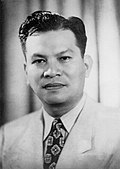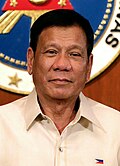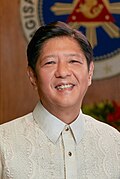Top Qs
Timeline
Chat
Perspective
List of presidents of the Philippines
From Wikipedia, the free encyclopedia
Remove ads
Remove ads
Under the Constitution of the Philippines, the president of the Philippines (Filipino: Pangulo ng Pilipinas) is both the head of state and government, and serves as the commander-in-chief of the country's armed forces.[3][4] The president is directly elected by qualified voters to a six-year term and must be "a natural-born citizen of the Philippines, a registered voter, able to read and write, at least forty years of age on the day of the election, and a resident of the Philippines for at least ten years immediately preceding such election". No elected president can seek re-election. Upon resignation, or removal from the office, the vice president assumes the post. A president's successor who hasn't served for more than four years can still seek a full term for the presidency.[5]

Remove ads
History
Summarize
Perspective
Emilio Aguinaldo became the inaugural president of the Philippines under the Malolos Republic, which was considered the First Philippine Republic.[6][note 2] He held that office until 1901 when he was captured by United States forces during the Philippine–American War (1899–1902).[3] The American colonization of the Philippines abolished the First Republic,[11] which led to an American governor-general exercising executive power.[18]
In 1935, the United States, pursuant to its promise of full Philippine sovereignty,[19] established the Commonwealth of the Philippines following the ratification of the 1935 Constitution, which also restored the presidency. The first national presidential election was held,[note 3] and Manuel L. Quezon (1935–44) was elected to a six-year term with no provision for re-election[4] as the second Philippine president and the first Commonwealth president.[note 2] In 1940, however, the Constitution was amended to allow re-election but shortened the term to four years.[3] However, a change in the government occurred three years later when the Second Philippine Republic was organized with the enactment of the 1943 Constitution, which Japan imposed after the occupied the Philippines in 1942 during World War II.[22] José P. Laurel acted as puppet president of the new Japanese-sponsored government;[23] his de facto presidency,[24] not legally recognized until the 1960s,[10] overlapped with that of the president of the Commonwealth, which went into exile. The Second Republic was dissolved after the Japan surrendered to the Allies in 1945; the Commonwealth was then restored in the Philippines in the same year with the election of Sergio Osmeña (1944–46) as president.[3]
Manuel Roxas (1946–1948) then followed Osmeña when he won the first post-war election in 1946. He became the first president of the independent Philippines when the Commonwealth ended on July 4 of that year. The Third Republic was ushered in and would cover the administrations of the next five presidents, the last of which was Ferdinand Marcos (1965–86),[3] who performed a self-coup by imposing martial law in 1972.[25] The dictatorship of Marcos saw the birth of the New Society (Filipino: Bagong Lipunan) and the Fourth Republic. His tenure lasted until 1986 when he was deposed in the People Power Revolution. The current constitution came into effect in 1987, marking the beginning of the Fifth Republic.[3]
Of the individuals elected as president, three died in office: two of natural causes (Manuel L. Quezon[26] and Manuel Roxas[27]) and one in a plane crash (Ramon Magsaysay, 1953–57[28]). The longest-serving president is Ferdinand Marcos with 20 years and 57 days in office; he is the only president to have served more than two terms. The shortest is Sergio Osmeña, who spent 1 year and 300 days in office.
Two women have held the office: Corazon Aquino (1986–92), who ascended to the presidency upon the successful People Power Revolution of 1986, and Gloria Macapagal Arroyo (2001–10), who, as vice president, ascended to the presidency upon Estrada's resignation and was elected to a full six-year term in 2004.
Remove ads
Presidents
Timeline

Remove ads
Unofficial presidents
Summarize
Perspective
Andrés Bonifacio is considered by some historians to be the first president of the Philippines. He was the third Supreme President (Spanish: Presidente Supremo; Tagalog: Kataastaasang Pangulo) of the Katipunan secret society. Its Supreme Council, led by the Supreme President, coordinated provincial and district councils. When the Katipunan went into open revolt in August 1896 (the Cry of Balintawak), Bonifacio transformed it into a revolutionary government with him as president. While the term Katipunan remained, Bonifacio's government was also known as the Tagalog Republic (Tagalog: Republika ng Katagalugan; Spanish: Republica Tagala). (Although the word Tagalog refers to a specific ethnicity, Bonifacio used it to denote all indigenous people in the Philippines in place of Filipino which had colonial origins.)[30][31][32][33][34]
Some historians contend that including Bonifacio as a past president would imply that Macario Sakay and Miguel Malvar y Carpio should also be included.[35] Miguel Malvar y Carpio continued Emilio Aguinaldo's leadership of the First Philippine Republic after the latter's capture until his own capture in 1902. Macario Sakay revived the Tagalog Republic in 1902 as a continuation of Bonifacio's Katipunan. They are still both considered by some scholars as "unofficial presidents". Along with Bonifacio, Malvar and Sakay are not recognized as presidents by the Philippine government.[36][37]
Emilio Aguinaldo is officially recognized as the first president of the Philippines, but this is based on his term of office during the Malolos Republic, later known as the First Philippine Republic. Prior to this Aguinaldo had held the presidency of several revolutionary governments which are not counted in the succession of Philippine republics.
Manuel L. Quezon delegated his presidential duties to José Abad Santos, the then Chief Justice, when the former fled the Philippines amidst Japanese occupation of the islands to establish a government-in-exile. He is believed to have in effect become the acting president of the Philippine Commonwealth though no legal document has been retrieved detailing the official transfer of the title of President to Abad Santos.[38]
List
Timeline

Remove ads
List of presidents by age
Remove ads
List of presidents by offices held before presidency
Summarize
Perspective
Executive branch
Vice presidents
3 other former vice presidents (S. Laurel, Binay, and Robredo) all made failed runs for the presidency.
Cabinet secretaries
The following cabinet secretaries are only served for fulltime. Vice Presidents served as cabinet secretary concurrently are not included.
Other positions
Legislative
Senators
Congressman/Representatives/Assemblyman
Local government
Governors
Mayors
Municipal/City Councilors
Judiciary
International Affairs-related
Presidents who had not previously held elective office
Without previous experience in government, but served in the military
Without previous experience in government or in the military
Remove ads
List of presidents by military service
Remove ads
Notes
Summarize
Perspective
- The president has three official residences, with the Malacañang Palace Complex as the principal abode and workplace.[1] The others are Mansion House in Baguio, the official summer residence,[2] and Malacañang of the South, the official residence in Davao City.
- In chronological order, the presidents started with Manuel L. Quezon,[7] who was then succeeded by Sergio Osmeña as the second president,[8] until the recognition of Emilio Aguinaldo[9] and José P. Laurel's[10] presidencies in the 1960s.[subnote 1][subnote 2] With Aguinaldo as the first president and Laurel as the third, Quezon and Osmeña are thus listed as the second and the fourth respectively.[3][17]
- Emilio Aguinaldo, the official first president, was elected by the Malolos Congress and not by popular vote.[20][21]
Subnotes
- The Malolos Republic, an independent revolutionary state that is actually the first constitutional republic in Asia,[11][12] remained unrecognized by any country[13][14] until the Philippines acknowledged the government as its predecessor,[15] which it also calls the First Philippine Republic.[11][9][16] Aguinaldo was consequently counted as the country's first president.[6][9]
Other notes
- Date on which Aguinaldo formally swore allegiance to the United States and published a manifesto to the Philippine people to lay down their weapons after being captured by American forces in Palanan, Isabela on March 23 of the same year.
- Elected by the Malolos Congress.
- Executive authority was held by American military governors from August 14, 1898 until July 1, 1902 and by American governors-general from July 4, 1901 until November 15, 1935.
- American military governors were appointed by the president of the United States exercising his powers as commander-in-chief.
- American governors-general were appointed by the president of the United States, with advice and consent of the United States Senate.
- Japanese-sponsored Second Republic dissolved following the surrender of Japan in World War II.
- Elected by the National Assembly.
- Removed from office and went into exile following the People Power Revolution.
- The 1973 Constitution was amended in 1984 to restore the vice presidency, but an election was not called until 1986.
- In the 1986 presidential election, Ferdinand Marcos was declared the winner by the Batasang Pambansa and the Commission on Elections, while Corazon Aquino was declared the winner by the National Citizens' Movement for Free Elections. The fraudulent conduct and disputed result of the election led to the People Power Revolution.
- Resigned from office following the Second EDSA Revolution, with the Supreme Court confirming the constitutionality of his resignation on March 2, 2001.[29]
- Term began when Bonifacio declared the establishment of the Tagalog Republic.
- Term ended after the Tejeros Convention.
- Term was established at the Tejeros Convention; Aguinaldo took his oath of office the day after (March 23), but did not fully assume the office until late April 1897.
- Term ended with the establishment of the Republic of Biak-na-Bato.
- Term began after the establishment of the Republic of Biak-na-Bato.
- Term ended when Aguinaldo signed the Pact of Biak-na-Bato.
- Term began with the declaration of a revolutionary government replacing the dictatorship.
- Term ended with the inauguration of the First Philippine Republic.
- Term ended when Malvar surrendered in Batangas.
- Term began when Sakay declared the establishment of the Tagalog Republic (in the tradition of Bonifacio instead of Aguinaldo).
- The running-mate of former President Ferdinand Marcos in the February 1986 presidential election. Proclaimed himself as acting president in a coup attempt.
Remove ads
See also
References
External links
Wikiwand - on
Seamless Wikipedia browsing. On steroids.
Remove ads
























